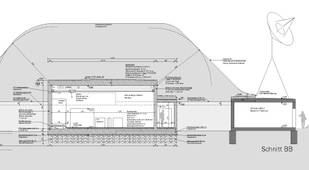New TUM Underground Laboratory under construction
20.05.2009 —
Over the past few weeks construction has been taking place: The excavation work for the new underground laboratory (UGL2) in Garching began mid-March. The Technische Universität München and the Excellence Cluster „Universe“ are making an important contribution to astroparticle physics in Germany with the new laboratory. The newly constructed UGL comprises over 130 square metres of usable laboratory area and will be open to other European work groups within the framework of future major projects in astroparticle physics. Completion of the laboratory is planned for the end of 2009.
A core topic of astroparticle physics is neutrino research. Neutrinos are generated during fusion reactions inside stars and during stellar explosions, but were also formed during the dawn of the universe. Another core topic is dark matter: Hitherto unknown particles also come into consideration as possible candidates for this form of matter, which makes up approximately 80 percent of the total matter of the universe.
The UGL2 serves as a development and test station for detection equipment, with which these particles can be detected. The detectors are used in large-scale research projects throughout Europe. These include international collaborations such as the experiment to build a search for dark matter CRESST, the future EURECA experiment, Double Chooz in France, and a future 50kt detector for neutrino astronomy.
Image: More space for astroparticle physics at the Technische Universität München - cross section of the new Underground Laboratory // © aichner-kazzer architekten
An apparatus for the testing of low-temperature detectors is planned for the new UGL which can be operated at one hundredth of a degree above absolute zero, for example for the detection of dark matter particles. An additional main focus of the work in the UGL is the development and testing of liquid scintillators which emit light signals as soon as they detect a sought-after particle. In the already existing UGL scientists are working on the development and testing of such detectors.
Neutrinos occur extremely frequently on the earth, nevertheless they are extremely difficult to verify as they are neutral and rarely interact with their environment. The detectors must therefore be highly sensitive and react specifically to the sought-after particles. Furthermore, interfering background occurrences caused by muons must be suppressed. These particles are generated when cosmic rays strike the atmosphere.
This is why the development of new detection methods takes place in a protected environment. The UGL2 will be installed with 6 metres of protection underground: This corresponds to an equivalent of 15 metres underwater: This makes it possible to reduce the number of muons per square metre per second by approximately one third. Other components of the interfering cosmic radiation are blocked virtually completely.







